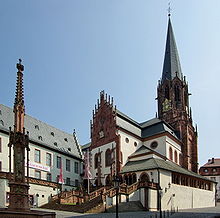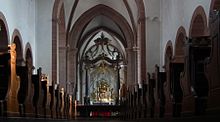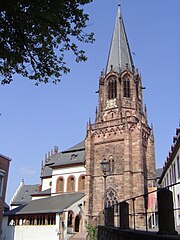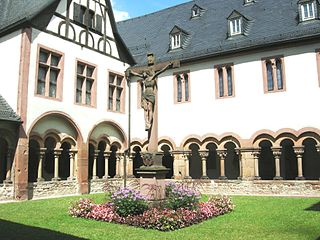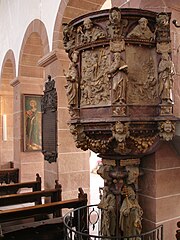
Albert of Brandenburg was a German cardinal, elector, Archbishop of Mainz from 1514 to 1545, and Archbishop of Magdeburg from 1513 to 1545.

Aschaffenburg is a town in northwest Bavaria, Germany. The town of Aschaffenburg is not part of the district of Aschaffenburg, but is its administrative seat.

Schöllkrippen is a market community in the Aschaffenburg district in the Regierungsbezirk of Lower Franconia (Unterfranken) in Bavaria, Germany and seat of the Verwaltungsgemeinschaft of Schöllkrippen. It has a total population of around 4,300 (2020).

A rood or rood cross, sometimes known as a triumphal cross, is a cross or crucifix, especially the large crucifix set above the entrance to the chancel of a medieval church. Alternatively, it is a large sculpture or painting of the crucifixion of Jesus.

Seligenstadt is a town in the Offenbach district in the Regierungsbezirk of Darmstadt in Hesse, Germany. Seligenstadt is one of Germany's oldest towns and was already of great importance in Carolingian times.

St Peter's Cathedral is a Roman Catholic church and former cathedral in Worms, southern Germany.
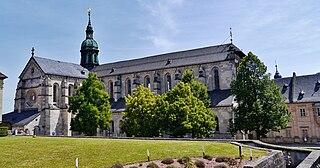
Ebrach Abbey is a former Cistercian monastery in Ebrach in Oberfranken, Bavaria, Germany, now used as a young offenders' institution.

Limburg Cathedral (German: Limburger Dom, also known as Georgsdom after its dedication to Saint George, is located above the old town of Limburg in Hesse, Germany. It is the cathedral of the Catholic Diocese of Limburg. Its high location on a rock above the river Lahn provides its visibility from far away. It is the result of an Early Gothic modernization of an originally Early Romanesque building and therefore shows a Romanesque-Gothic transitional style.

Sulzbach am Main is a market municipality in the Miltenberg district in the Regierungsbezirk of Lower Franconia (Unterfranken) in Bavaria, Germany.
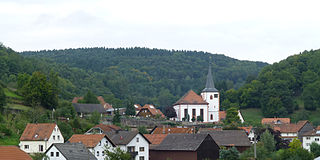
Flörsbachtal is a municipality in the Main-Kinzig district, in Hesse, Germany. It has a population close to 2,400. Flösbachtal contains both the oldest parish and the youngest settlement established in the Spessart hills. Located within the municipal territory is the Hermannskoppe, the highest elevation in the Hessian part of the Spessart and the Wiesbüttmoor, a rare hanging bog.
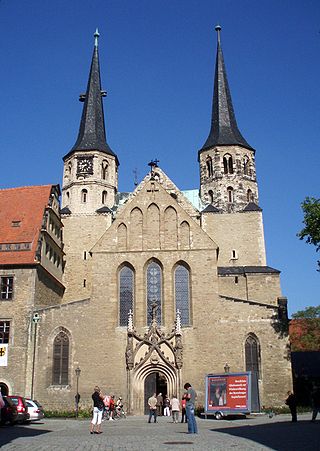
Merseburg Cathedral is the proto-cathedral of the former Bishopric of Merseburg in Merseburg, Germany. The mostly Gothic church is considered an artistic and historical highlight in southern Saxony-Anhalt.
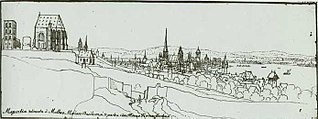
St. Alban's Abbey, Mainz originated as a Benedictine abbey, founded in 787 or 796 by Archbishop Richulf (787–813) in honour of Saint Alban of Mainz, located to the south of Mainz on the hill later called the Albansberg. It was turned into a collegiate foundation (Herrenstift) in 1442. The buildings were entirely destroyed in 1552, although the foundation retained a legal existence until its formal dissolution in 1802.

The Basilica of St. Castor is the oldest church in Koblenz in the German state of Rhineland Palatinate. It is located near Deutsches Eck at the confluence of the Rhine and the Moselle. A fountain called Kastorbrunnen was built in front of the basilica during Napoleon's invasion of Russia in 1812. Pope John Paul II raised St. Castor to a basilica minor on 30 July 1991. This church is worth seeing for the historical events that have occurred in it, its extensive Romanesque construction and its largely traditional furnishings.

St. Peter's Church is located beneath Deutschhaus Mainz in the northwest of the historical center of Mainz, Germany. It is one of the most important rococo buildings in Mainz. Originally it was a collegiate church monastery of ″St. Peter before the walls″, which had existed since the 10th century and is dedicated to the apostle Peter as patron. Today it serves as a parish church for the parish of St. Peter / St. Emmeran.

Neustadt am Main Abbey was an abbey of the Benedictine Order in Neustadt am Main, Bavaria, Germany. It existed from the 8th century until the dissolution of abbeys in the course of secularization in 1803. During its heyday in the early Middle Ages, the abbey was a political power that vied for regional influence with the Prince-bishops of Würzburg, the Archbishops of Mainz and the Counts of Rieneck. Today its location is occupied by a monastery operated by the nuns of the "Dominican Order of Saint Catherine of Siena", also known as Kloster Neustadt. The former abbey church today serves as the Catholic parish church for Neustadt.

The church of St Lubentius in Dietkirchen, now part of Limburg an der Lahn, Hesse, Germany, was the most important church of the region until the 13th century. Located on top of a rock outcrop on the west bank of the river Lahn, it holds relics of St Lubentius, who according to the Gesta Treverorum worked in the area as a missionary in the fourth century. Today, the former collegiate church serves as the Catholic parish church of Dietkirchen, while its former chapel Dreifaltigkeitskapelle is the Protestant parish church. The church is a Romanesque basilica, mostly built in the 11th and 12th centuries, with a double tower at the west end.

Halle Cathedral is an Evangelical Reformed Church, and is the oldest surviving church in the old part of the city Halle, Saale. Beside it resided the Archbishop of Magdeburg, who ruled the city for a long period. Albert of Brandenburg remodelled the church's exterior from 1520 onwards and built the neighbouring Neue Residenz, aiming to make the church one of the most influential and powerful monasteries north of the Alps.

St. Johannes Evangelist is a Catholic parish church in Cappenberg, now part of Selm, North Rhine-Westphalia, Germany. It was formerly the abbey church of Cappenberg Abbey built in Romanesque style. It is a listed monument as one of few extant large churches built before the mid-12th century in Westphalia.

St Severus' Church in the city of Erfurt in Thuringia, Germany, is a Roman Catholic church building. It stands on the Domberg directly next to St Mary's Cathedral. As a unique architectural ensemble, both churches together form the city's landmark. Due to its unusual form, which seems to anticipate the late Gothic hall church, St Severus' Church is one of the most important Gothic buildings in Germany. The bones of the church patron Severus of Ravenna rest in an artistically very significant sarcophagus.
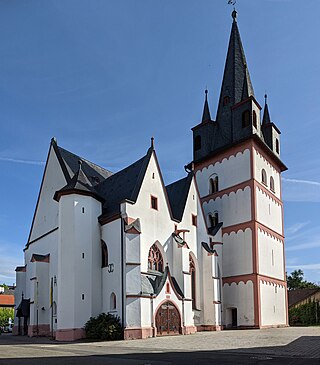
St. Martin is the name of a Catholic church and former parish in Oestrich, Rheingau-Taunus-Kreis, Germany. It was built as a hall church from 1508 in late-Gothic style. It was destroyed in the Thirty Years' War and rebuilt in simpler style, but restored to its Gothic appearance in 1894.
